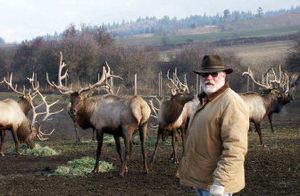Veterinarians to Idaho: Don’t risk importing parasitic worm with farmed elk
UPDATE: Click here for news on the committee's Feb. 24 vote.
WILDLIFE -- Despite adamant opposition and warnings by the Idaho Fish and Game Department director, the Idaho Legislature is continuing to pursue a controversial proposal that would ease restrictions on importing and transferring farm-raised elk that could expose wild deer, elk and moose to a deadly parasitic worm.
The rule change is scheduled for a vote on Tuesday in the Idaho Legislature's Senate Agricultural Affairs Committee.
This is not just an Idaho issue. Meningeal worms are a problem some scientists have dubbed as "ebola for wildlife."
If the committee approves the rule change, the ramifications will be potentially catastrophic to wild cervids and domestic animals, particularly white-tailed deer as well as mule deer, big horn sheep, exotic deer, elk, moose, caribou, llamas, alpacas, sheep and goats.
If Idaho gets meningeal worm, Washington State will be exposed, too.
Making this change in Idaho is nuts, considering that elk ranchers have safer alternatives.
- The West just recently has had its eyes reopened to the threat of Chronic Wasting Disease in farmed elk in Utah as well as in Alberta.
This is not a time to roll the dice with a possible travesty that has no known cure for wild big-game populations.
Don't take my word for it, or just the word of IFG director Virgil Moore. Listen to a pair of Idaho veterinarians who have clearly spelled out their opposition to the rule change in the following letter they've sent to Idaho lawmakers.
A Perfect Storm: Brainworm in Idaho’s Wildlife & Legislature
By Drs. Olin & Karen Balch, Cascade, IdahoAs Valley County veterinarians, we are alarmed about Idaho’s legislative rule proposal to downgrade meningeal worm restrictions for elk importation from east of the 100th meridian, essentially the eastern half of the US. Current Idaho regulations prohibit elk importation from meningeal worm endemic regions. The Senate Agricultural Committee chaired by Sen. Jim Rice is scheduled to vote on this issue Tuesday.
Likely, few Idahoans are familiar with meningeal worm disease or Brainworm. Briefly, adult meningeal worms live in the central nervous system of white-tailed deer (definitive host) without harming that species. The life cycle involves larva excreted in white-tailed deer feces; the larva then matures to an infective stage in a snail or slug (intermediate host). Deer or other forage browsers inadvertently ingest snails or slugs carrying the disease while feeding. Brainworm as a species is so successful that 80% of white-tailed deer in some eastern locations are infected. Unfortunately, the adult meningeal worm living in the CNS is neither treatable nor identifiable.
Successfulness of numerous elk reintroduction efforts in eastern US have been marred by documented Brainworm mortality from 3% in Michigan, 24% in Kentucky, to 50% in Pennsylvania. Scientific studies conclusively prove that elk can perpetuate this disease by shedding infective larva but do not necessarily die from Brainworm. Brainworm in elk and mule deer is devastating; Brainworm in moose is catastrophic. Minnesota moose population plummeted so drastically that the 2013 and 2014 Minnesota moose hunting seasons were cancelled.
Idaho has arguably the biggest US concentration of cervid wildlife (deer, elk, and moose), all of which can be infected with Brainworm. We have abundant white-tailed deer, and our species of snail and slugs are suitable intermediate hosts. We have all the makings of a perfect storm:
1) the definitive host, white-tailed deer,
2) the intermediate host, slugs and snails, and
3) huge herds of wild cervids as previously-unexposed, vulnerable bystanders.
The match would be a meningeal-worm infected captive elk introduced into some Idaho elk farm visited by white-tailed deer. Once Idaho white-tailed deer are infected, Brainworm will be an unquenchable wildfire in Idaho’s wild cervids.
Elk breeders apparently feel that their livelihood is imperiled by their inability to bring in fresh elk genetics from eastern US. We question why A.I. (artificial insemination) would not be the safe solution for obtaining new elk genetics; although seemingly all eastern US elk are descendants of western Rocky Mountain elk transplants.
We are baffled by elk farmer’s insistence that it is discrimination that elk meningeal–worm import regulations are not as lenient as import requirements of domestic animals (such as llamas, sheep, and horses) which can also be Brainworm infected. However, these domestic animals have not been shown to pass viable larva capable of perpetuating the disease.
As veterinarians, we believe animal import requirements should not be a matter of “fairness” but rather a scientific matter of the species’ specific physiology, the specific disease manifestation in that species, and the transmissibility of the disease to other animals or humans. For example, horses and cattle can become rabid and transmit that almost invariably fatal disease, but are not required to have proof of rabies vaccination for import into Idaho. Is it discrimination that dog owners must rabies vaccinate and show proof of vaccination to enter Idaho when similar requirements do not exist for owners of horses and cattle?
We are also baffled why state legislators are so willing to jettison the official June 23, 2014, written advice of IDFG Director Moore: “It is imperative that the prohibition be maintained.”

